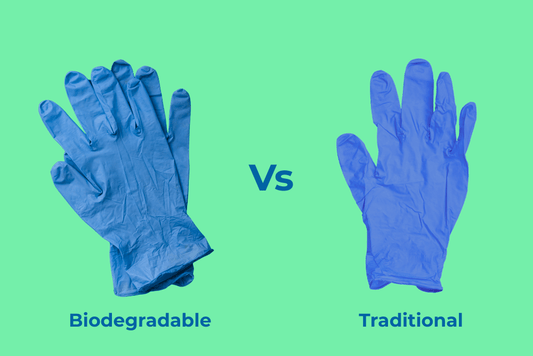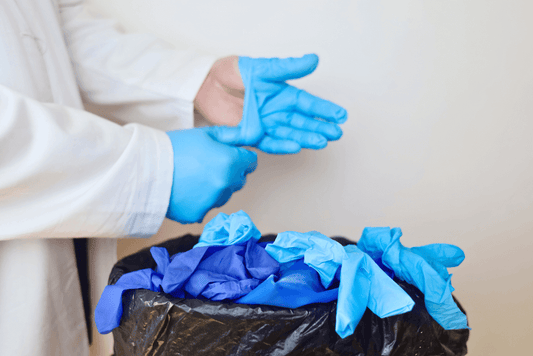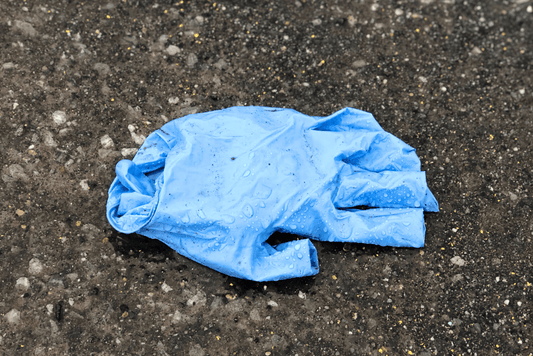Nitrile Vs. Latex Vs. Vinyl: Choosing the Right Glove & Understanding Its Afterlife
Gloves have become everyday items in healthcare, laboratories, food handling, and even household tasks. They act as a barrier between the skin and potential contaminants. But not all gloves are created from the same materials. Nitrile, latex, and vinyl are the three primary types, each with distinct properties, applications, and environmental impacts upon disposal.
This article explains how these gloves differ, their strengths and limits, and what happens to them after disposal.
Latex Gloves - The Traditional Choice
Latex gloves are produced from natural rubber tapped from rubber trees. They have been in use for decades and are well known for elasticity and comfort. The material allows high sensitivity to touch, making it popular in medical and dental fields where precision is required.
Latex stretches without tearing easily. The snug fit means users can work with accuracy. The biodegradability of latex is often highlighted as a positive feature. Under the right conditions, latex can break down faster than synthetic alternatives.
However, latex is not without drawbacks. Allergic reactions are a significant concern. Some individuals experience skin irritation or more severe responses. This has pushed many organisations to reduce reliance on latex in favor of alternatives.
Nitrile Gloves - The Modern Alternative
Nitrile gloves are made from synthetic rubber known as nitrile butadiene. They are more resistant to punctures and chemicals than latex. This makes them the glove of choice in laboratories, industrial environments, and high-risk medical procedures.
Unlike latex, nitrile has no protein content that causes allergies. It is also more durable, withstanding oils, solvents, and certain chemicals. For users who need long-lasting protection, nitrile is often preferred.
On the downside, nitrile gloves are not naturally biodegradable. Without specialized recycling or energy recovery processes, they persist in landfills for many years. Their widespread adoption has created growing concerns around disposal.
Vinyl Gloves - The Affordable Option
Vinyl gloves are produced from polyvinyl chloride (PVC). They are less elastic and less durable than latex or nitrile, but they are inexpensive and quick to manufacture. Vinyl gloves are commonly used in food service, light cleaning, and other low-risk tasks.
They provide a looser fit and break more easily under stress. For short-term, low-contact use, this may not matter. For applications requiring safety under pressure, vinyl is often considered inadequate.
From an environmental perspective, vinyl gloves pose challenges. PVC is not biodegradable and can release harmful substances during disposal or incineration. Recycling options for vinyl are limited. This makes their after-use impact higher compared to other types.
Comparing Performance and Applications
Latex: High sensitivity, natural origin, but allergenic.
Nitrile: Strong, chemical-resistant, allergy-free, but less eco-friendly.
Vinyl: Cheap, quick to use, limited strength, poor environmental record.
The selection depends on the context. Surgeons may choose latex or nitrile for precision and safety. Food handlers might use vinyl for tasks lasting minutes. Laboratories often favor nitrile for chemical protection. Cost, availability, and safety standards influence decisions.
What Happens After Disposal?
The journey of gloves does not end once they are discarded. Their disposal pathways differ, but most follow one of three routes: landfill, incineration, or recycling.
Landfill: Gloves are frequently thrown away with general waste. Latex breaks down faster than synthetics, but still not immediately. Nitrile and vinyl linger much longer, with limited decomposition. Landfill disposal contributes to waste accumulation.
Incineration: Some facilities burn medical or contaminated gloves. This reduces volume but raises other concerns. Burning nitrile and vinyl can release gases and residues if not handled in controlled systems. High-temperature incineration with filtration minimizes this, but access to such systems is uneven.
Recycling: True recycling of gloves is possible, but not widespread. Latex and nitrile can be processed in specialized facilities where they are shredded, melted, or chemically treated to form new materials. Vinyl is rarely recycled due to PVC’s composition. Recycling requires clean, uncontaminated gloves, which are often impractical in healthcare.
The Challenges of Recycling Gloves
Sorting gloves for recycling is complex. Used gloves are often contaminated, making them unsuitable for immediate processing. Removing contamination requires resources, which adds to the cost.
Latex gloves, though biodegradable, do not always reach conditions where degradation occurs. They may stay intact for years in oxygen-poor landfill sites.
Nitrile gloves need chemical processes to be reused effectively. Some pilot programs in Europe and Asia are working on recovering nitrile at scale, breaking it down into base components, and reconstituting usable material.
Vinyl gloves remain the most difficult. Their additives and chlorine content complicate recycling systems. Few facilities attempt it.
Industrial Take-Back and Recovery Programs
Some companies and hospitals are experimenting with glove collection schemes. Boxes placed in medical facilities allow segregation of gloves from other waste. These are sent to specialized plants for processing.
Nitrile glove recycling is seeing the most investment, particularly for non-contaminated gloves used in laboratories. Once processed, the recovered material can form flooring, mats, or even new gloves in limited cases.
Government and industry collaboration is slowly improving infrastructure. Regulations in certain regions are pushing organisations to manage medical waste more responsibly, with recycling as one of the targeted methods.
Consumer-Level Action
For individuals, the role is smaller but still relevant. Choosing gloves wisely can reduce waste. If nitrile gloves are available, they often last longer per use than vinyl, reducing total consumption.
Where reusable alternatives are possible, such as household cleaning with washable gloves, these can substitute for single-use varieties. Donation of unopened, unused gloves to local charities or community groups prevents unnecessary waste.
Reading product labels helps identify material type. Understanding whether a glove is latex, nitrile, or vinyl informs its disposal prospects.
The discussion around glove use and disposal is growing. Demand for disposable gloves remains high, but pressure to reduce waste is shaping industry responses. Biodegradable nitrile alternatives are being developed. More advanced recycling methods are being trialed.
The biggest hurdle remains contamination. Until effective systems exist to separate and treat used gloves safely, most will still go to landfill or incineration.
Future progress depends on better product design, broader recycling facilities, and consumer cooperation. Latex, nitrile, and vinyl will each continue to serve specific purposes. Managing their afterlife responsibly will be the shared responsibility of producers, institutions, and users.
Gloves are indispensable across healthcare, laboratories, and industries. Each type, latex, nitrile, and vinyl, brings different advantages and limitations, both in use and after disposal. Progress is underway to reduce their impact, though challenges remain.
Upgrade your operation confidently! Our FDA-compliant biodegradable nitrile gloves deliver the protection and assurance you need to meet the highest food safety standards, all while providing a simple, positive step toward sustainability. Contact our sales team immediately for verified product certifications and bulk pricing: Call +44 7482 212945 or visit our contact page.








